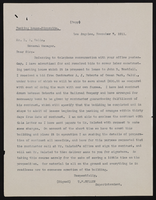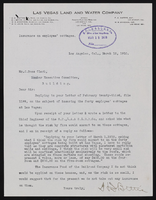Search the Special Collections and Archives Portal
Search Results
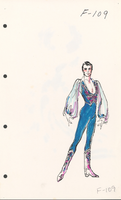
Costume design drawing, blue ballet costume for male dancer, Las Vegas, 1981
Date
1981
Archival Collection
Description
Bob Mackie design. Transcribed from original drawing index: "4 Principal boy dancers (Vienna, ballet look)."
Costume Details: Male dancer in blue ballet style costume with sheer ballooned sleeves; decorated with fuchsia trim; matching boots.
Show Name: Jubilee!
Performance Name: Bandwagon finale: Vienna
Site Name: MGM Grand Hotel and Casino
Costume Details: Male dancer in blue ballet style costume with sheer ballooned sleeves; decorated with fuchsia trim; matching boots.
Show Name: Jubilee!
Performance Name: Bandwagon finale: Vienna
Site Name: MGM Grand Hotel and Casino
Image
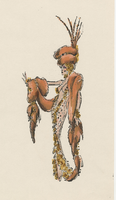
Costume design drawing, topless gold digger showgirl #4, Las Vegas, June 5, 1980
Date
1980-06-05
Archival Collection
Description
Bob Mackie design. Transcribed from original drawing index: "Girl singer (Gold digger showgirl #4)."
Costume Details: Showgirl wearing a transparent long dress with brown fur stole, both decorated with yellow and gold jewels resembling coins. A gold and yellow jeweled headdress is topped with brown fur and feathers.
Show Name: Jubilee!
Performance Name: Bandwagon finale: B-Babies
Site Name: MGM Grand Hotel and Casino
Costume Details: Showgirl wearing a transparent long dress with brown fur stole, both decorated with yellow and gold jewels resembling coins. A gold and yellow jeweled headdress is topped with brown fur and feathers.
Show Name: Jubilee!
Performance Name: Bandwagon finale: B-Babies
Site Name: MGM Grand Hotel and Casino
Image

Costume design drawing, teal, pink and black showgirl costume, Las Vegas, June 5, 1980
Date
1980-06-05
Archival Collection
Description
Bob Mackie design. Transcribed from original drawing index: "8 black girl dancers (Jeweled, black, split skirts)."
Costume Details: Jeweled teal, pink, and black vertical striped showgirl costume with split skirt, matching feather headdress and cuffs.
Show Name: Jubilee!
Performance Name: Bandwagon finale: Gershwin
Site Name: MGM Grand Hotel and Casino
Costume Details: Jeweled teal, pink, and black vertical striped showgirl costume with split skirt, matching feather headdress and cuffs.
Show Name: Jubilee!
Performance Name: Bandwagon finale: Gershwin
Site Name: MGM Grand Hotel and Casino
Image

Costume design drawing, topless showgirl in purple and black ensemble, Las Vegas, 1981
Date
1981
Archival Collection
Description
Bob Mackie design. Transcribed from original drawing index: "Nude showgirl (Purple #1)."
Costume Details: Topless showgirl in jeweled purple and black collar and split skirt costume with large matching trailing headdress trimmed in purple and black feathers; teal and fuchsia accents. The costume was worn from the opening night of Jubilee, July 1981 until May 1984.
Show Name: Jubilee!
Performance Name: Bandwagon finale: Stairway
Site Name: MGM Grand Hotel and Casino
Costume Details: Topless showgirl in jeweled purple and black collar and split skirt costume with large matching trailing headdress trimmed in purple and black feathers; teal and fuchsia accents. The costume was worn from the opening night of Jubilee, July 1981 until May 1984.
Show Name: Jubilee!
Performance Name: Bandwagon finale: Stairway
Site Name: MGM Grand Hotel and Casino
Image
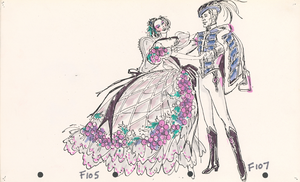
Costume design drawing, Vienna finale costumes, Las Vegas, 1981
Date
1981
Archival Collection
Description
Bob Mackie design. Transcribed from original drawing index: "16 Bluebells (Vienna hoopskirts); 16 Male dancers (Vienna-Military)."
Costume Details: Female performer in pale pink hoop skirt costume decorated with large fuchsia and purple grapes, black ribbons at waist, and teal hair ribbons. Male performer wearing a stylized military uniform costume with white tights, blue jacket, cape and hat trimmed with black feathers, and black boots.
Show Name: Jubilee!
Performance Name: Bandwagon finale: Vienna
Site Name: MGM Grand Hotel and Casino
Costume Details: Female performer in pale pink hoop skirt costume decorated with large fuchsia and purple grapes, black ribbons at waist, and teal hair ribbons. Male performer wearing a stylized military uniform costume with white tights, blue jacket, cape and hat trimmed with black feathers, and black boots.
Show Name: Jubilee!
Performance Name: Bandwagon finale: Vienna
Site Name: MGM Grand Hotel and Casino
Image
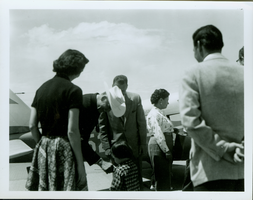
Rex Bell (George Francis Beldam) shaking a child's hand at an airport. Other people are unidentified and location is unknown: photographic print
Date
1880 to 1979
Archival Collection
Description
Dorothy Bell Scans UNLV-Public Lands Institute
Image
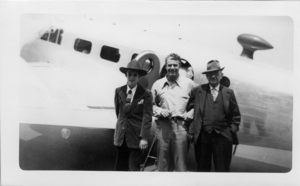
Rex Bell (George Francis Beldam) center), with two other unidentified people at an unknown location in front of an airplane: photographic print
Date
1880 to 1979
Archival Collection
Description
Dorothy Bell Scans UNLV-Public Lands Institute
Image
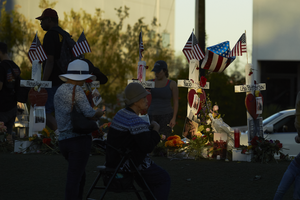
People gather and view the crosses at the 1 October memorial located at the Welcome to Las Vegas sign, looking east-northeast in Las Vegas, Nevada: digital photograph
Date
2017-10-06
Archival Collection
Description
Following the October 1, 2017 killing of 58 people at the Route 91 Harvest Music Festival on the Las Vegas Strip, the Las Vegas community responded in a variety of ways. This series of photographs document the impromptu memorial created at the Welcome to Las Vegas sign.
Image
Pagination
Refine my results
Content Type
Creator or Contributor
Subject
Archival Collection
Digital Project
Resource Type
Year
Material Type
Place
Language
Records Classification

